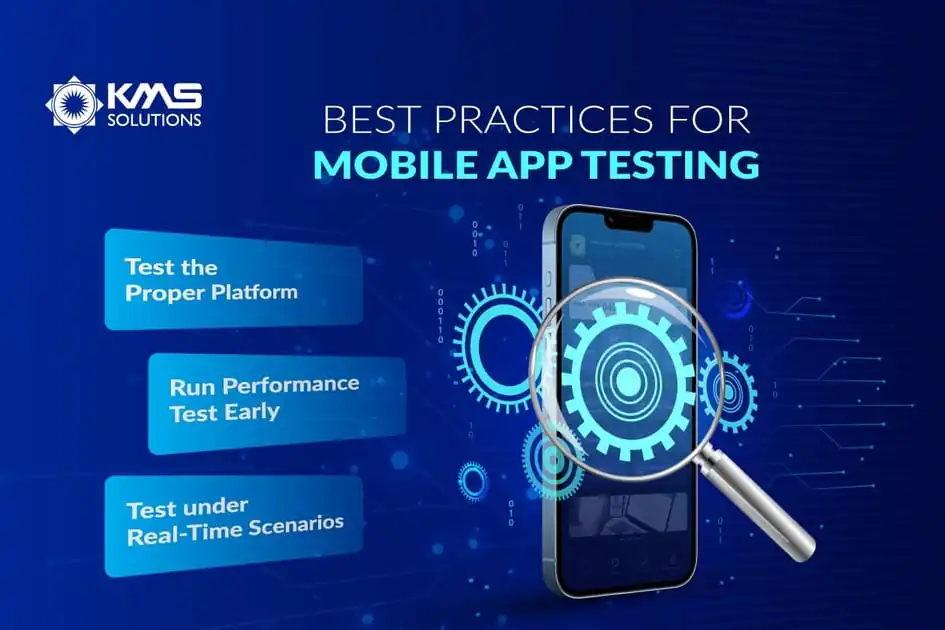Testing is an essential part of the mobile app development process as a whole to ensure a seamless experience for all customers. However, mobile app testing can be error-prone, time-consuming and even expensive – if not done appropriately.
Nowadays, it’s effortless to find a plethora of tips for optimising the mobile app testing process available on Google; however, not all of them are practical. By working with over 100 businesses worldwide, we’ve identified some common testing difficulties and come up with the following best practices for your mobile testing strategy.
1. Test the Proper Platform
Depending on which platform your app is developed for – Web-based, Native, or a Hybrid of the two, the testing technique will be distinct. A native app provides the most control over the experience, but it requires significantly more effort to maintain across multiple platforms owing to the diversity of device hardware and operating systems.
Otherwise, native and hybrid apps implement distinct underlying technologies but are similar in the functionality they provide. Thus, they have the same functional testing approach, such as testing the app’s built-in device resources, gesture testing, screen orientation testing, etc.
Web-based app testing has different obstacles. You’ll have to handle several types of browsers (natively developed for the device or standard browsers), performance/load testing, and, probably most essential, how the app functions with varied device screen sizes in the age of responsive and adaptive Web design.
2. Understand Your Customers

To develop an appealing mobile app, a large amount of data about your end customers is required. Only if you know how the potential users interact with the app, can you make better business decisions, prioritise development, and refine the user experience with more engaging touchpoints.
By working with the development team to build analytical mechanisms into the app, QA specialists can understand the user behaviour and test any parts that are mostly used. With product analytics tools such as Mixpanel, you can identify any factors of your design that frustrate people, where they get confused, and what keeps them from converting.
Measuring end-user data is critical not only for determining appropriate strategies for mobile app, but also for making relevant business decisions.
3. Functionality First, User Experience Second
Any app’s key selling point is its fundamental functionality, which needs to be rock solid. The main reason that people look for an app is it can perform particular functions and meet their requirements. Since incomplete or inadequate functionality will result in app abandonment, it’s essential to ensure that the main functions are thoroughly executed and tested before launching.
Besides, mobile apps have to be user-friendly and slick. The development team will need to rework it if the functionality doesn’t flow intuitively, or the user interface is poorly designed.
The best practice in testing here is not to wait until the app is finished to evaluate user experience. As soon as the prototype or design mock-up is complete, you may begin testing the user experience early in the development cycle.
4. Rely on Real Device Testing Before Launching
In the early phases of app development, testing on emulators and simulators is a highly beneficial strategy. They offer improved debugging capabilities to accelerate the app’s testing lifecycle.
However, it is also critical to test the mobile app on actual mobile devices. Before releasing the app, real device testing is worth considering. It offers more precise results by permitting testers to check every possible scenario in the testing cycle. Hence, the flaws can be corrected instantly based on the realistic output.
5. Run Performance Test Early
When performance problems are discovered later in the development cycle, it is frequently more expensive and dangerous to make modifications after functional testing is complete. Hence, running a performance test at the early stage can help detect all the possible performance issues.
However, performance testing is not a one-and-done process, and a single test cannot provide developers with all the information they want. Repetition is necessary for a performance test to be genuinely successful.
6. Smart Balanced Testing
It’s important to keep a balance between exploratory testing and script-based testing. In fact, script-based testing won’t be useful for determining emotional involvement, and this kind of testing typically requires more time to complete in order to obtain the appropriate degree of coverage.
On the other hand, session-based testing can be implemented effectively for identifying user experience issues, edge case scenarios, and certain usage conditions. To guarantee the most thorough coverage possible, you’ll need to get the mix right.
7. Use a Cloud-service to Test on More Devices

A real device cloud is a testing environment that consists of real iOS, Android, and other mobile devices accessible from the desktop browser. Mobile device cloud lets app developers and QA experts access app performance insights, switch devices effortlessly, and perform automated tasks.
When testing the mobile app is time-consuming, Katalon Testcloud leverages unlimited concurrency to reduce time-to-market. In comparison to physical device testing, when a certain feature is missed, you’ll have to wait, With the real device cloud, you can test from anywhere with instant access to thousands of devices, debugging and releasing faster.
8. Split the Testing Process into Smaller Units
Breaking down the testing process into smaller units and conducting the tests individually is one of the possible ways to get more accurate results and accelerate the testing process. These units may be used to test certain app features or components. Splitting the tests assists in targeting every aspect of the app and doing thorough testing.
9. Test under Real-Time Scenarios
One of the biggest advantages of real-time testing is that it fits into your already existing development processes. It’s essential to test mobile apps under real-time settings, such as poor network connectivity, separate timezones, GPS locations, SMS interruptions, low-battery notifications, and so on.
With a suitable testing tool, you can go beyond the usual device testing and test under real user scenarios, i.e. natural app gestures/interactions, in-app purchases, payment workflows, geotargeting, etc.
10. Identify your Support Policy
It’s difficult to test every set of browsers, platform, and operating system. To stay up with the pace of the mobile industry, define your support strategy early on and review it around every three months.
Identify your target devices and platform versions using end-user data and market research. Generally, the testing should be concentrated on any devices and OS that have the greatest number of end customers. Moreover, it’s worth considering limiting support for outdated platforms since it may cost you enormous.
11. Refine and Optimize
To enhance and optimise mobile apps, there’re some specific test types that should be implemented. Testers can apply A/B testing to determine which options end customers prefer and base final choices on the results.
Besides, by using optimization testing, you can make judgements on small, uncomplicated UI and functionality modifications. Fake-door testing may also be utilised early in the development process to evaluate which new features end customers are most interested in.
12. Combine Manual Testing with Automation Testing
The key to fusing automated testing and manual testing is to identify which is most appropriate for each feature and particular phase of the product development.
Manual testing is still pivotal since it enables you to cover a wide variety of devices, locations, and UX tests from a human standpoint. However, incorporating automation into your test plan for mobile apps may make manual mobile application testing more efficient, quicker, and more accurate.
Experts tips for fusing manual and automation testing consists of:
- Add regular automated tests to manual testing
- White-box testing, load tests, and performance tests should all be automated.
- Any test that is performed repeatedly is suitable for automation
- For scalable, time-efficient testing, use crowd testing
- Consider scheduling manual tests after important design or development cycles
Conclusion
Developing a successful mobile app is not simple, and the best practices in testing naturally evolve over time. But most of our tips above are essential for every mobile app tester and developer out there.
Over the course of 13 years working with many clients globally, KMS Solutions has successfully implemented these best practices to accelerate the testing process as well as improve product’s quality. Moreover, we’re partnering with some most famous testing tools, like Katalon and Kobiton, to provide you with the most suitable testing solutions. Thus, resulting in higher qualified products. Unlock the full potential of your mobile app with our Mobile Application Testing Solutions today!











